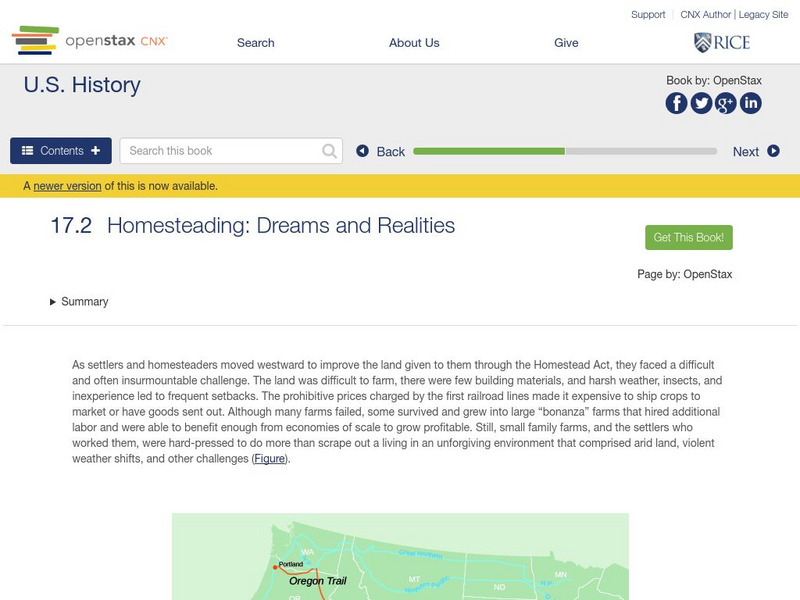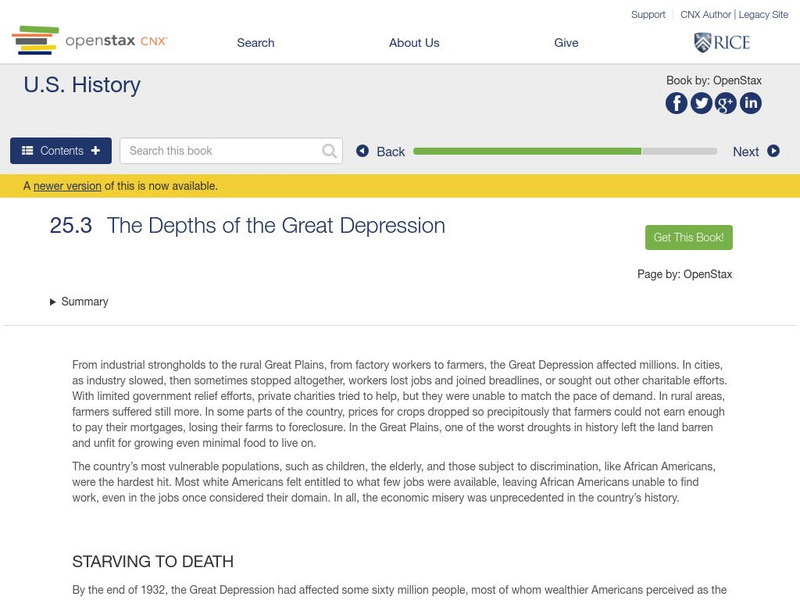OpenStax
Open Stax: Catherine Schmidt Jones: Music Conducting: Classroom Activities
An excellent lesson plan that helps students learn the role of a music conductor. Students will engage in various activities that allow them to have a hands on approach to conducting their classmates.
OpenStax
Open Stax: Catherine Schmidt Jones: Interval
Learn about simple intervals and compound intervals in this well writtern lesson. You will also learn how an interval is classified. Included are several self checking problems.
OpenStax
Open Stax: Catherine Schmidt Jones: Key Signature
Learn about key signatures with this well written tutorial. You can test what you have learned near the bottom of the page with a key signature problem. The solution is available with just a click of the mouse.
OpenStax
Open Stax: Anatomy & Physiology: Water Balance
Learn how water levels in the body influence the thirst cycle and body fluid regulation. Find out about dehydration and identify common causes of dehydration.
OpenStax
Open Stax: Chemical Reactions
This site provides an overview of the role of energy in chemical reactions.
OpenStax
Open Stax: Anatomy and Physiology: Types of Tissues
The term tissue is used to describe a group of cells found together in the body. Although there are many types of cells in the human body, they are organized into four broad categories of tissues: epithelial, connective, muscle, and...
OpenStax
Open Stax: Anatomy and Physiology: Connective Tissue
One of the major functions of connective tissue is to connect tissues and organs. Learn all about connective tissue here.
OpenStax
Open Stax: Exercise, Nutrition, Hormones, and Bone Tissue
All of the organ systems of your body are interdependent, and the skeletal system is no exception. The food you take in via your digestive system and the hormones secreted by your endocrine system affect your bones. Even using your...
OpenStax
Open Stax: Anatomy and Physiology: Nervous Tissue
Learn here about nervous tissue, tissue that is composed of two types of cells - neurons and glial cells.
OpenStax
Open Stax: Anatomy and Physiology: The Function of Nervous Tissue
Learn here about how nervous tissue is capable of communicating within the nervous system.
OpenStax
Open Stax: Anatomy & Physiology: Body Fluids and Fluid Compartments
Learn about the chemical and physical characteristics of the fluids that make up the human body.
OpenStax
Open Stax: Work, Energy, and Power in Humans
In the following interactive students will begin to explain the human body's consumption of energy when at rest vs. when engaged in activities that do useful work. They will also calculate the conversion of chemical energy in food into...
OpenStax
Open Stax: Conservation of Momentum
From a chapter on Linear Momentum and Collisions in a Physics textbook. This section of the chapter discusses the principle of conservation of momentum and the expression for it, along with examples. It then explains the role this...
OpenStax
Open Stax: Homesteading: Dreams and Realities
After reading this section from a chapter on "Westward Expansion", students will be able to identify the challenges that farmers faced as they settled west of the Mississippi River and describe the unique experiences of women who...
OpenStax
Open Stax: The Great Depression 1929 1932: President Hoover's Response
Examines how Herbert Hubert responded to the crisis of the Great Depression and his personal belief system that caused him to respond that way. Also looks at how governments at other levels addressed the Great Depression, and why most...
OpenStax
Open Stax: Elements and Atoms, the Building Blocks of Matter
This site provides an overview of elements and atoms, the building blocks of matter.
OpenStax
Open Stax: Andrew R. Barron: Valence Shell Electron Pair Repulsion (Vsepr) Theory
Detailed explanation of Valence Shell Electron Pair Repulsion (VSEPR) Theory with examples and questions for the reader to check comprehension. Also includes step-by-step instructions for correctly building molecules using VSEPR Theory....
OpenStax
Open Stax: Anatomy & Physiology: Anatomy of the Lymphatic and Immune Systems
Students learn and apply understanding of the structure and function of the components of the human lymphatic and immune systems.
OpenStax
Open Stax: Anatomy & Physiology: Organs and Structures of the Respiratory System
Students learn and understand the structures that make up the respiratory system, and then apply that knowledge to understand the process of oxygen and carbon dioxide exchange.
OpenStax
Open Stax: Anatomy and Physiology: The Urinary System and Homeostasis
Students learn how the functions of the urinary system and other systems of the human body are interrelated.
OpenStax
Open Stax: Anatomy and Physiology: Female Reproductive System
Students learn about the structure and function of the organs of the female reproductive system.
OpenStax
Open Stax: Anatomy and Physiology: Male Reproductive System
Students learn about the structure and function of the organs of the male reproductive system.
OpenStax
Open Stax: The Great Depression 1929 1932: The Depths of the Great Depression
Examines the challenges faced by the average American, by African Americans, and by farmers on the Great Plains during the Great Depression, and the government's response or lack thereof.
OpenStax
Open Stax: Gyroscopic Effects: Vector Aspects of Angular Momentum
From a chapter on Rotational Motion and Angular Momentum in a Physics textbook. This section of the chapter explains how to use the right-hand rule to determine direction for angular velocity, momentum, and torque. Also discusses the...

















